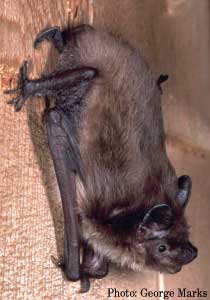| Range: |
Extreme lower Michigan and northern Illinois, east to southern New Jersey, west to central Nebraska and central Texas, south into Mexico and Florida. They're somewhat rare throughout most of their range, except in the coastal areas of the southeast. Evening bats, along with Brazilian free-tailed bats, are the species most often seen in the Tampa Bay region. |
| Anatomy: |
The evening bat is one of the smaller bats. They usually weigh less than half an ounce and their tiny bodies fit easily in the palm of a hand. With a wingspan of about eight inches, evening bats appear to be much larger when they're flying. Their wings are created by a membrane called a patagium, which stretches between their body and elongated fingers that are similar to human hands. Evening bats also have an uropatagium that stretches between their legs. They sometimes use this wide tail to catch insects. They have brown fur complemented by black ears, snouts and wings. |
| Diet: |
Bats eat insects, but data on which bats prefer what bugs is somewhat limited. A study in Indiana indicates that evening bats dine primarily on spotted cucumber bugs, an important agricultural pest. In Florida, evening bats also have been seen foraging for mosquitoes.
These bats emerge early and are most often seen foraging in the early evening and again just before dawn. They appear to prefer open areas, and are often visible over open fields and ponds. They may even follow roadways through suburban areas. Female evening bats will return to the roost to feed their young periodically during the night. |
| Habitat: |
Evening bats typically roost in tree hollows, although they can be found in bat houses (often sharing the space with other bats, especially the Brazilian freetailed). In Florida, researchers have seen them leave bat houses in late summer and winter, then return in the early spring of the following year to establish maternity colonies. No one knows why they leave or where they go. |
| Life Cycles: |
Evening bats have a relatively short life span of about 10 years, compared with other bats that may live as long as 30 years. Mating typically occurs in the fall, and one to two pups are born between mid-May and early June. The newborns are pinkish and naked, with a few scattered hairs. By day five the skin darkens and fur begins to grow. They can fly on their own by three weeks. |
|





